|
.
In Etoges in 1814, the French cavalry surrounded
a Russian horse battery. The gunners drew sabers
and fought their way through. Their guns were also saved.
|

Generals, Officers and Gunners.
"The are formidable duelers"
- French infantryman
The Russian gunners were known for their physical strength.
The French recalled that at Borodino the Russian gunners were "formidable duelers" when faced with French grenadiers. Officer Vasili Grigorievich Kostenetzki was very popular among gunners. This colossus could break a horseshoe with his bare hands. He also carried a pallash of enormous size and length which he used at Borodino against the French infantry.
The gunners were trained in their companies (batteries). Additionally there were 10 privates and 2 NCOs in each infantry company trained in artillery duties. It gives 96-144 men per musketier regiment, in jager regiments the number was two or three times lower as the jagers were shorter and weaker men not well suited for heavy physical labor in artillery.
In case of heavy casulaties among gunners these infantrymen were taken as replacement. Such change often took place in the heat of the battle.
Unfortunately we don't have much information on how and where the officers were trained. Between 1800 and 1825 the First and the Second Moscow Academy provided 890 artillery officers. The guard artillery's instructional companies trained additional 900 officers and NCOs. For nobles who volunteered to join the artillery, qualifications were still higher than for those in infantry and cavalry, and even in the guard.
In 1811 artillery officers below lieutenant-colonel (podpolkovnik) became one rank
above infantry and cavalry officers. The Guard was not included in it.
The rank of major was discontinued in artillery and engineers.
Alexei Arakcheiev
Inspector General of Artillery
and ultra-conservative politician
 Count Alexei Aleksandrovich Arakcheiev was Russia's foremost artillery expert. In 1803 he served as the Inspector General of Artillery and reorganized this arm. Arakcheiev introduced lighter gun carriages and lighter caissons. Since 1808 Arakcheiev published "Artillery Journal."
Count Alexei Aleksandrovich Arakcheiev was Russia's foremost artillery expert. In 1803 he served as the Inspector General of Artillery and reorganized this arm. Arakcheiev introduced lighter gun carriages and lighter caissons. Since 1808 Arakcheiev published "Artillery Journal."
In 1808-1810, he served as the Minister of War and was one of the politicians responsible for war against Sweden. He urged generals to cross the frozen Baltic Sea and capture Finland.
Arakcheiev was nicknamed "The Bulldog" because of the systematic rudeness displayed in barking out orders. He was a harsh disciplinarian, feared not only by the rank and file, but also by officers and generals. This man was a very vicious intimidator who nevertheless basked in over-inflated self-reliance and even enjoyed his unpopularity. With an attitude of superiority he led a Spartan lifestyle. Strangely Arakcheiev never distinguished himself in combat. According to Prussian officer Clausewitz, Arakcheiev was a Russian in every sense of the word, of great energy and cunning. (Clausewitz - "The Campaign of 1812 in Russia" p 9)
Arakcheiev developed into one of Tzar's most trusted confidants. After the Napoleonic Wars the Tzar had withdrawn from domestic politics and Arakcheiev became de facto the ruler of Russian Empire. Arakcheiev designed and organized the hated military colonies.
Alexei Yermolov
From horse artillery to
the chief of staff.
 Alexei Petrovich Ermolov was a robust bear of a man and ardent character. The tyrant, Tzar Paul, disliked Yermolov for his liberal views. Yermolov first served under Suvorov in Italy and then fought against Persia. He distinguished himself at Austerlitz, Eylau, Borodino and Kulm.
In 1807 Yermolov commanded horse artillery of the hard fighting Bagration's rearguard.
In the battle of Eylau, Yermolov took 36 horse guns, rode to Anklappen and opened a tremendous fire on the French. (It was Davout's corps in the process of outflanking the Russian army.) At Borodino Kutusov dispatched him to handle the crisis at Raievski's Redoubt. Yermolov brought 36 guns from the reserve, and showered the French with canister halting their advance.
Despite horrible casualties suffered by the Russians at Borodino, Yermolov was spoiling for another battle. He was vigorously protesting against abandoning Moscow without a fight.
Alexei Petrovich Ermolov was a robust bear of a man and ardent character. The tyrant, Tzar Paul, disliked Yermolov for his liberal views. Yermolov first served under Suvorov in Italy and then fought against Persia. He distinguished himself at Austerlitz, Eylau, Borodino and Kulm.
In 1807 Yermolov commanded horse artillery of the hard fighting Bagration's rearguard.
In the battle of Eylau, Yermolov took 36 horse guns, rode to Anklappen and opened a tremendous fire on the French. (It was Davout's corps in the process of outflanking the Russian army.) At Borodino Kutusov dispatched him to handle the crisis at Raievski's Redoubt. Yermolov brought 36 guns from the reserve, and showered the French with canister halting their advance.
Despite horrible casualties suffered by the Russians at Borodino, Yermolov was spoiling for another battle. He was vigorously protesting against abandoning Moscow without a fight.
Yermolov was not only a gunner, he also served as chief of staff of the army and commander of the Guard.
- in 1811 appointed the chief of staff of the 3rd Western Army.
- in 1812 became chief of staff of the 1st and 2nd Western Army.
- in January of 1813 served as commander of artillery in Kutusov's column.
- in May appointed as commander of Artillery Reserve.
- in October commanded the Guard Infantry (two divisions).
Alexander Kutaisov
Son of a Turk, he studied artillery
in Vienna and Paris.
As a 10-year-old Alexander Ivanovich Kutaisov was already serving in the Russian Guard. His father was a Turk captured by Russians in the Russian-Turkish war.
Kutaisov spoke fluently in three European languages and was quite talented painter.
In 1810 he studied languages, mathematics and artillery in Vienna and in Paris.
Kutaisov distinguished himself at Golymin, Eylau and Friedland. At the age of 22 Kutaisov was already a general. During the 1812 campaign he was the youngest of Russian generals and commanded the artillery of the First Western Army. He was killed at Borodino.
Yermolov wrote: "After some time Kutaisov's horse came back and the blood-stained saddle led us to believ this brave general had been killed." Kutuzov lamented "The army lost its artillery commander in a battle where much depended on artillery".
Nikitin.
Aggressive Commander of Horse Artillery.
At Borodino Nikitin's battery suffered badly but continued firing to the very end.
Nikitin distinguished himself at Krasne and Maloyaroslavetz. At Krasne his 7th Horse Artillery Company fired canister at the retreating French, then mounted and charged with broadswords in hand. They captured 2 guns and 300 men.
At Malo-Yaroslavetz his gunners captured enemy’s battery !
In 1813 at Lutzen, Nikitin with 40 horse guns rushed to the frontline and produced a "tremendous fire". In 1814 at La Rothiere Nikitin pushed 24-36 guns within musket range of the French voltigeurs and opened fire. At Craonne he used artillery to cover the retreat of infantry and cavalry: in the first line were placed 36 6pdr guns, 60 paces back were 28 12pdr guns. The first line fired canister, the second fired shells.
Kapzevich.
 General Kapzevich was one of the several known gunners of the Russian army.
Firstly he served in the Pavlovsk Garrison before entering in 1796 the Lifeguard Artillery Battalion.
In 1797 he was promoted to the rank of colonel, and in the same year (!) became general-major.
In 1801 he became chef of the 5th Artillery Battalion, and in 1804 chef of the 7th Artillery Regiment.
Then Kapzevich served in Georgia and Caucassus where he held the overall command of the artillery.
In 1808 he became a general attached to the Ministry of War.
In 1810 Kapzevich commanded an infantry division and distinguished himself at Smolensk, Borodino and Malo-Yaroslavetz. In 1813 he commanded an infantry corps and distinguished himself at Leipzg. After Napoleonic Wars he commanded an independent corps
stationed in Siberia. Kapzevich died in 1840.
General Kapzevich was one of the several known gunners of the Russian army.
Firstly he served in the Pavlovsk Garrison before entering in 1796 the Lifeguard Artillery Battalion.
In 1797 he was promoted to the rank of colonel, and in the same year (!) became general-major.
In 1801 he became chef of the 5th Artillery Battalion, and in 1804 chef of the 7th Artillery Regiment.
Then Kapzevich served in Georgia and Caucassus where he held the overall command of the artillery.
In 1808 he became a general attached to the Ministry of War.
In 1810 Kapzevich commanded an infantry division and distinguished himself at Smolensk, Borodino and Malo-Yaroslavetz. In 1813 he commanded an infantry corps and distinguished himself at Leipzg. After Napoleonic Wars he commanded an independent corps
stationed in Siberia. Kapzevich died in 1840.
|

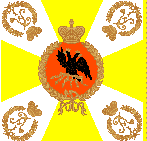


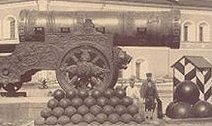 On picture: the largest cannon until 20th century, the Tsar Cannon
with stunning 40 tons weight and 5 m length ! In 1812 the retreating napoleonic troops
burned the wooden carriages but the super-gun survived.
On picture: the largest cannon until 20th century, the Tsar Cannon
with stunning 40 tons weight and 5 m length ! In 1812 the retreating napoleonic troops
burned the wooden carriages but the super-gun survived.
 Count Alexei Aleksandrovich Arakcheiev was Russia's foremost artillery expert. In 1803 he served as the Inspector General of Artillery and reorganized this arm. Arakcheiev introduced lighter gun carriages and lighter caissons. Since 1808 Arakcheiev published "Artillery Journal."
Count Alexei Aleksandrovich Arakcheiev was Russia's foremost artillery expert. In 1803 he served as the Inspector General of Artillery and reorganized this arm. Arakcheiev introduced lighter gun carriages and lighter caissons. Since 1808 Arakcheiev published "Artillery Journal."
 Alexei Petrovich Ermolov was a robust bear of a man and ardent character. The tyrant, Tzar Paul, disliked Yermolov for his liberal views. Yermolov first served under Suvorov in Italy and then fought against Persia. He distinguished himself at Austerlitz, Eylau, Borodino and Kulm.
In 1807 Yermolov commanded horse artillery of the hard fighting Bagration's rearguard.
In the battle of Eylau, Yermolov took 36 horse guns, rode to Anklappen and opened a tremendous fire on the French. (It was Davout's corps in the process of outflanking the Russian army.) At Borodino Kutusov dispatched him to handle the crisis at Raievski's Redoubt. Yermolov brought 36 guns from the reserve, and showered the French with canister halting their advance.
Despite horrible casualties suffered by the Russians at
Alexei Petrovich Ermolov was a robust bear of a man and ardent character. The tyrant, Tzar Paul, disliked Yermolov for his liberal views. Yermolov first served under Suvorov in Italy and then fought against Persia. He distinguished himself at Austerlitz, Eylau, Borodino and Kulm.
In 1807 Yermolov commanded horse artillery of the hard fighting Bagration's rearguard.
In the battle of Eylau, Yermolov took 36 horse guns, rode to Anklappen and opened a tremendous fire on the French. (It was Davout's corps in the process of outflanking the Russian army.) At Borodino Kutusov dispatched him to handle the crisis at Raievski's Redoubt. Yermolov brought 36 guns from the reserve, and showered the French with canister halting their advance.
Despite horrible casualties suffered by the Russians at  General Kapzevich was one of the several known gunners of the Russian army.
Firstly he served in the Pavlovsk Garrison before entering in 1796 the Lifeguard Artillery Battalion.
In 1797 he was promoted to the rank of colonel, and in the same year (!) became general-major.
In 1801 he became chef of the 5th Artillery Battalion, and in 1804 chef of the 7th Artillery Regiment.
Then Kapzevich served in Georgia and Caucassus where he held the overall command of the artillery.
In 1808 he became a general attached to the Ministry of War.
In 1810 Kapzevich commanded an infantry division and distinguished himself at Smolensk, Borodino and Malo-Yaroslavetz. In 1813 he commanded an infantry corps and distinguished himself at
General Kapzevich was one of the several known gunners of the Russian army.
Firstly he served in the Pavlovsk Garrison before entering in 1796 the Lifeguard Artillery Battalion.
In 1797 he was promoted to the rank of colonel, and in the same year (!) became general-major.
In 1801 he became chef of the 5th Artillery Battalion, and in 1804 chef of the 7th Artillery Regiment.
Then Kapzevich served in Georgia and Caucassus where he held the overall command of the artillery.
In 1808 he became a general attached to the Ministry of War.
In 1810 Kapzevich commanded an infantry division and distinguished himself at Smolensk, Borodino and Malo-Yaroslavetz. In 1813 he commanded an infantry corps and distinguished himself at 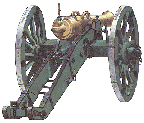 The Russians kept their canons and unicorns polished. The wooden parts of guns,
limbers and ammunition boxes were painted in green (some call it apple-green, others grass-green), while all the metal parts were painted in black.
The Russians kept their canons and unicorns polished. The wooden parts of guns,
limbers and ammunition boxes were painted in green (some call it apple-green, others grass-green), while all the metal parts were painted in black.
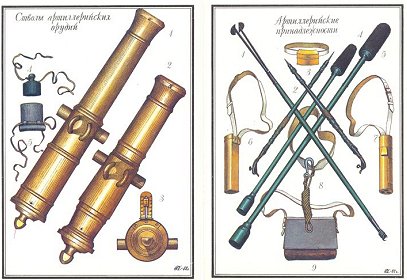 The guns were divided into two groups:
The guns were divided into two groups: Russia had the most numerous artillery in Europe. It also had a high number of heavy pieces. The very small number of guns they abandoned during all the campaigns speaks volumes for the exertions of their gunners and horses.
Russia had the most numerous artillery in Europe. It also had a high number of heavy pieces. The very small number of guns they abandoned during all the campaigns speaks volumes for the exertions of their gunners and horses.

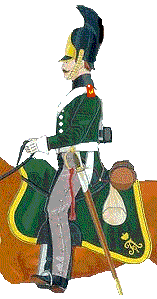 Left: Russian foot gunner in 1812.
Left: Russian foot gunner in 1812.
 .
.















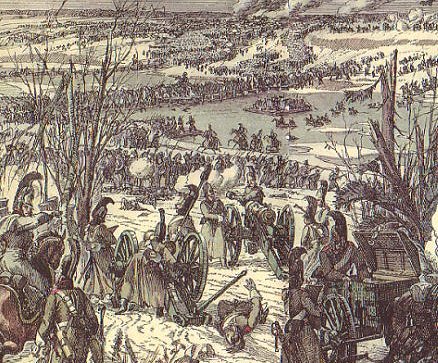 The main difference between the Russian and French artillery was not in the quality of gunners of guns but in the fact that Napoleon used artillery offensively while for the Russians
the main purpose of artillery was to defend cavalry and infantry. The same can be said about the supportive role of Prussian and British artillery.
Napoleon's artillery prepared the way for the final blow that would decide the battle.
The main difference between the Russian and French artillery was not in the quality of gunners of guns but in the fact that Napoleon used artillery offensively while for the Russians
the main purpose of artillery was to defend cavalry and infantry. The same can be said about the supportive role of Prussian and British artillery.
Napoleon's artillery prepared the way for the final blow that would decide the battle.
